Energy Rental Services on the Tron Network: Save Up to 80% on Transaction Fees
Introduction to Tron and Resource Rental
Tron (TRX) is one of the popular blockchains known for its low transaction fees, high throughput, and reliability. Instead of paying fees directly in TRX, the Tron network uses specialized resources: Bandwidth and Energy. While Bandwidth is sufficient for ordinary TRX transactions and TRC-10 tokens, smart contracts and TRC-20 tokens (for example, USDT) require Energy.
If there is not enough Energy or Bandwidth available, TRX is burned to make up the shortfall. If you do not have enough TRX in your balance, nor sufficient Energy or Bandwidth, you will not be able to perform a transaction or any other operation on the Tron blockchain.
How Resources are Acquired in Tron
1. Staking (Freezing) TRX
When you freeze a certain amount of TRX, you receive resources—either Bandwidth or Energy (you choose which resource you want in exchange for your frozen TRX).
At the same time, you receive Tron Power (TP), which allows you to vote for Super Representatives and earn additional rewards. The reward is approximately 4.5% per annum in TRX tokens.
Frozen TRX can be unfrozen, but not instantly: the unfreezing period is 14 days (according to the current network conditions).
The amount of Energy obtained for the same amount of TRX changes dynamically: the more people freeze TRX for Energy, the less Energy each participant receives.
2. Energy Rental
If you need to quickly execute transactions with tokens (for example, USDT) or interact with smart contracts but do not want to freeze a large sum of TRX for a long period, you can rent Energy from services specialized in this field.
Renting is significantly cheaper than burning TRX for each transaction (up to 80% savings or more) and does not require large initial investments.
Why Renting is More Advantageous than Burning TRX
If you do not have Energy in your wallet, the network will "convert" the required amount of smart contract computational power into TRX and burn it. With heavy use of TRC-20 tokens (for example, USDT), the fee can reach tens of TRX per transaction. For instance, 13.8 TRX is required to obtain 64,285 units of Energy and transfer USDT to an address that already holds USDT, and 27.35 TRX is needed to obtain 130,285 units of Energy for a transfer to an address that does not have USDT.
In contrast, when you have Energy (either your own or rented), you do not pay TRX for triggering a smart contract: the fee becomes zero or minimal. Therefore, even if renting Energy involves a fee in TRX, it is almost always cheaper than burning tokens for every transaction. Savings can reach 80% or more.
Why Renting Can Be More Advantageous Than Self-Staking
- No need to freeze large sums. To obtain 131,000 Energy (sufficient for one USDT transaction to a “clean” address without USDT), current network indicators require freezing about 11,684 TRX, which at a price of $0.242 (approximate cost at the time of writing) equals roughly $2,827.52. Moreover, this value changes dynamically: tomorrow, you might need even more TRX.
- Flexibility in usage. With rental, you pay a small fixed amount of TRX and receive the required amount of Energy for a specific period (a day, a week, a month, etc.). You won’t have to buy TRX every time or keep them frozen if they are needed for other purposes.
- Full Energy Recovery in 24 Hours. The spent Energy is restored to your account within a day. This means that if you rent, for example, 131,000 Energy for 30 days, you can execute one USDT transaction per day to a new address (which did not have USDT) or two transactions per day to an address that already holds USDT (requiring less Energy). Every 24 hours, the resource is replenished.
Thus, renting Energy is a convenient tool for those who do not want to invest in large-scale staking but regularly perform smart contract operations on the Tron network.
Overview of Energy Rental Services in the Tron Ecosystem
Below is a list of some of the most well-known platforms and services that provide Energy rental. They allow users to (a) avoid burning TRX for every transaction and (b) avoid freezing large sums. Please note that rental terms may change, so it is advisable to keep track of the latest offers.
1. Feee.io

Website: https://feee.io
A service specifically created for renting and trading Tron resources (Energy and Bandwidth). Key features:
- Exchange Trading: Allows you to create buy or sell orders for resources with the necessary parameters.
- Fast Transactions: The service automatically selects a suitable offer, and the required amount of Energy is credited to the user’s wallet within minutes.
- Earning Opportunities: Users with large TRX reserves can rent out their resources to other participants.
Feee.io is especially convenient for those who frequently perform transactions and want to save by avoiding systematic TRX burning.
2. Netts.io
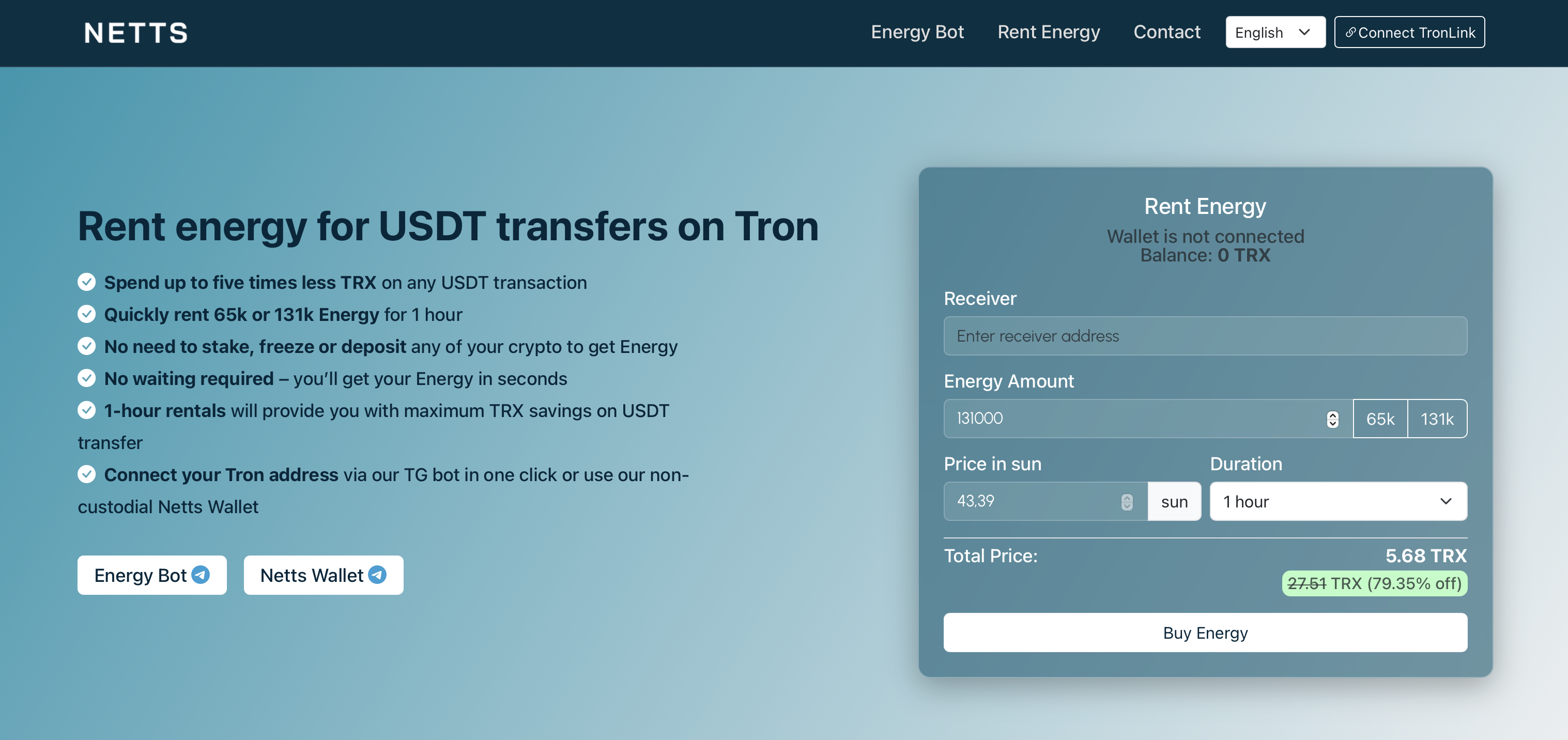
Website: https://netts.io/
Bot: https://t.me/netts_energy_order_bot
A service originally developed for convenient USDT transfers and Energy rental:
- Wallet “Charging”: You can obtain up to 131,000 units of Energy for two hours even with a minimal TRX balance in your wallet. Simply connect to the Telegram bot and “charge” your address before sending USDT, then complete the transfer using your wallet (TronLink, Trust Wallet, etc.).
- Flexible Rental: Allows you to rent the necessary amount of Energy for a specific period; auto-top-up can also be ordered when the Energy level drops.
- Netts Wallet: A non-custodial crypto wallet (a mini-app in Telegram) that allows you to:
- Send USDT even from an inactive (empty) wallet (no need for TRX or Energy on it).
- Pay fees in USDT if there is no TRX on the account.
- Offers some of the lowest prices on the market thanks to the aggregation of multiple Energy providers (pools and services).
Netts.io has already gained community recognition in Tron by offering flexible rental options and fee optimization. API development is also ongoing for integrating Netts solutions into any software, including a wallet API, along with additional solutions for Energy rental, pool management, and USDT transfers.
3. TronSave
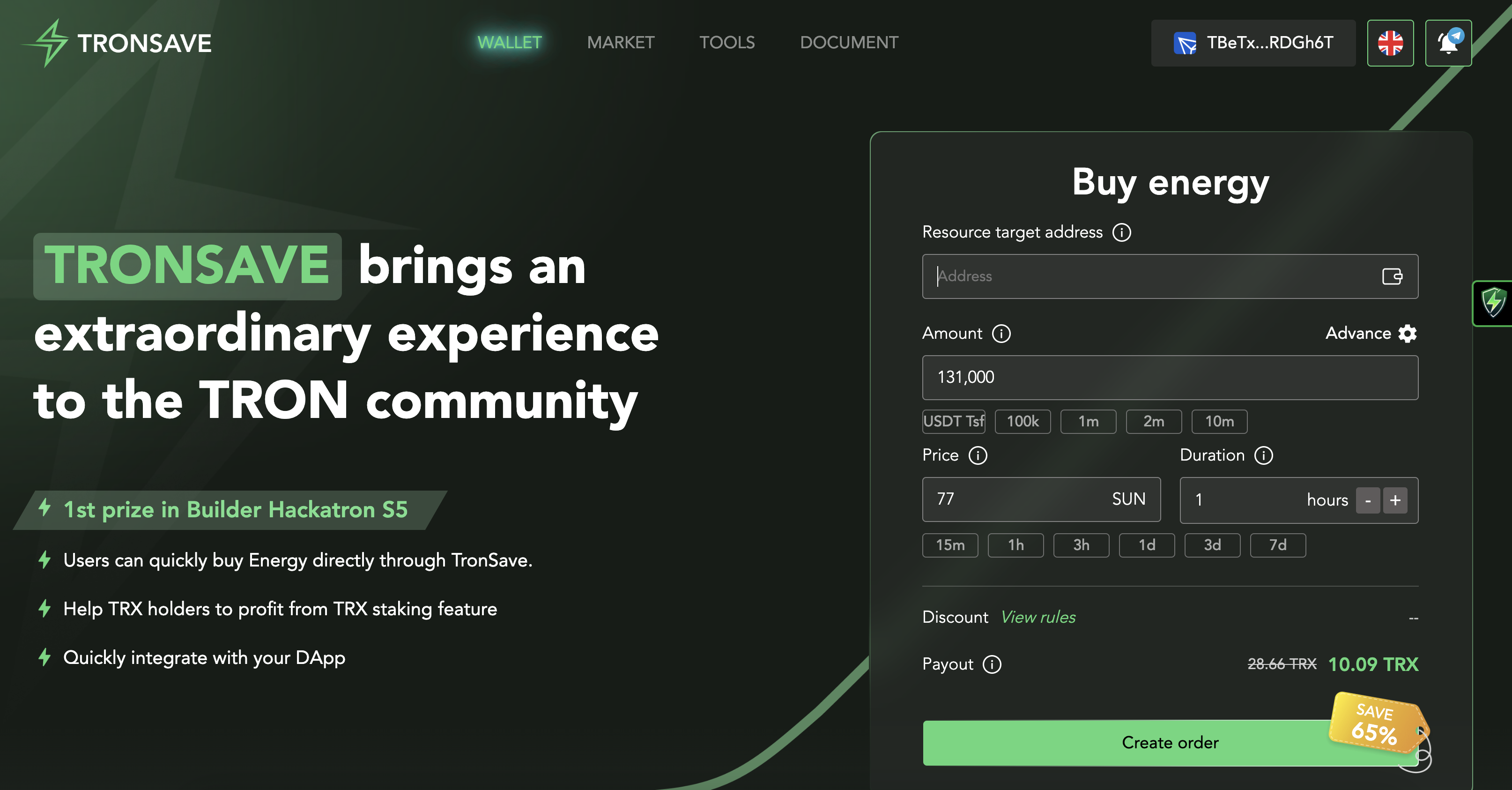
Website: https://tronsave.io/market
Wallet: https://savewallet.io/
TronSave is a platform built on the TRON Stake 2.0 mechanism aimed at reducing transaction costs in the Tron ecosystem while offering secure and reliable tools for working with Energy. The project has established itself through active participation in Tron Hackathon: it ranked in the Top 3 in Season 4 and won 1st place in the Builder category in Season 5, confirming the high quality and reliability of its solutions.
Key benefits for users:
- Up to 92% savings on transaction fees in the Tron network thanks to advantageous Energy rental.
- Simplicity and Convenience: Energy rental is available both for individuals and projects, with an intuitive interface.
- Earning on Unused Energy: Users who stake TRX can earn additional income by renting out their unused Energy.
Key benefits for Energy providers:
- Up to 25% APY on your staked TRX through providing Energy rental via TronSave.
- Stable Passive Income: You continue to receive staking rewards while renting out Energy to optimize profits.
- Flexibility and Reliability: You retain full control over your staked TRX while using its Energy to generate additional income.
Additional Tools:
- Bulk send (SaveSender): A service for mass token distribution to a large number of users—fast, convenient, and fee-optimized.
- Swap: An integrated exchange tool with SunSwap that enables the exchange of various crypto assets in just a few clicks.
- SaveWallet (savewallet.io): A crypto wallet designed for the Tron ecosystem that reduces network fees by up to 93% and supports DApps. The project also offers a convenient built-in swap for quick token conversion.
Thus, TronSave not only significantly reduces transaction costs but also allows you to earn extra income from your staked TRX. Users enjoy a high level of security and convenience, while the built-in tools (bulk send, swap, SaveWallet) make interacting with the Tron ecosystem even simpler and more cost-effective.
4. JustLend DAO
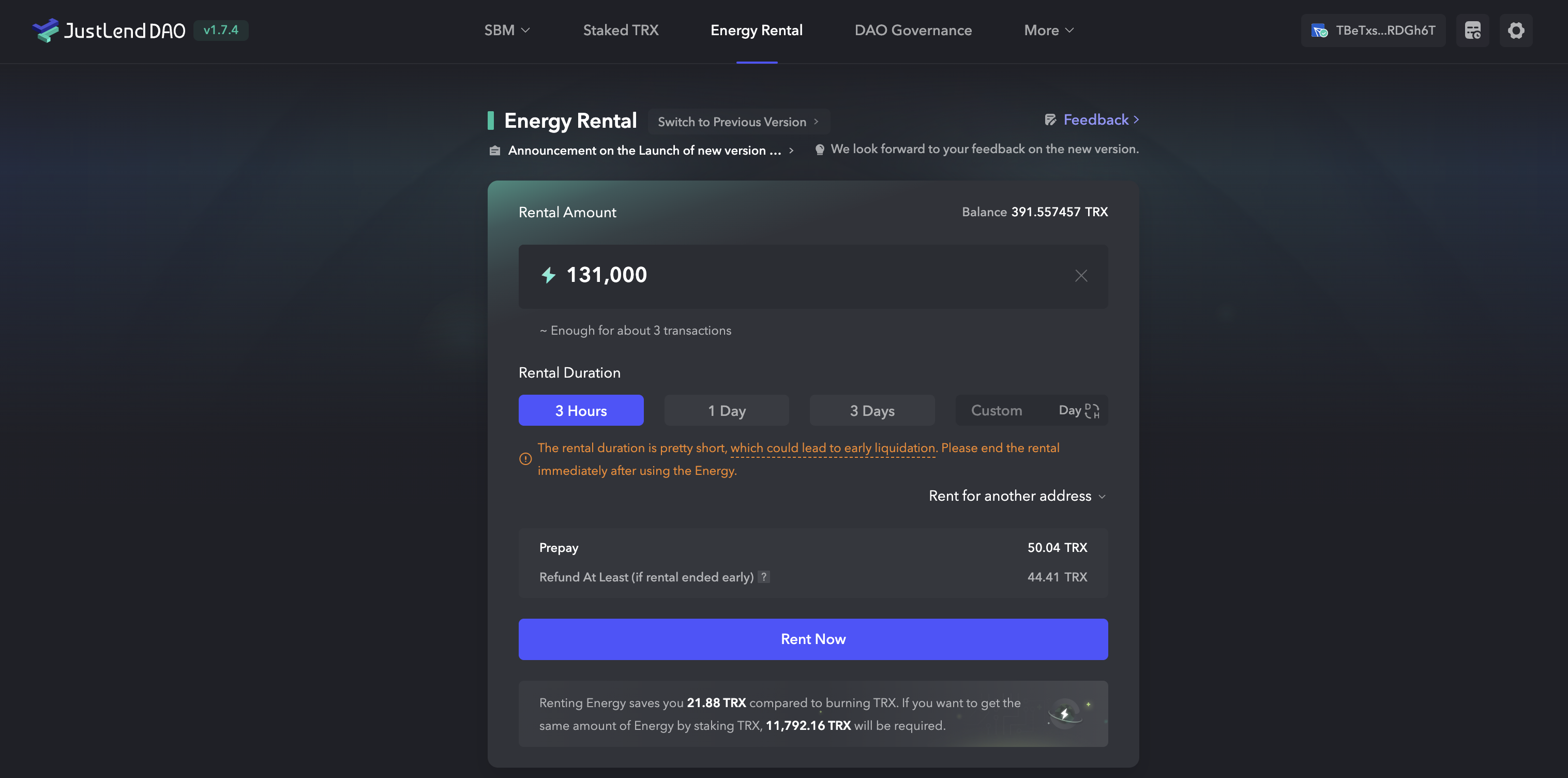
Website: https://app.justlend.org
One of the first DeFi platforms in the Tron ecosystem where you can lend and borrow assets, including crypto resources:
- Automated Lending Platform: Orders are matched without manual negotiations on rates.
- Energy Rental: One of the “byproduct” functions, where prices depend on market conditions, and you can specify the desired rental period.
- TRX is provided as collateral, which is returned upon the return of the rented Energy.
Although JustLend DAO is primarily oriented toward lending digital assets, it can also be used for Energy rental, though its interface might seem less convenient than that of specialized services.
5. Tron Energy Market (TEM)
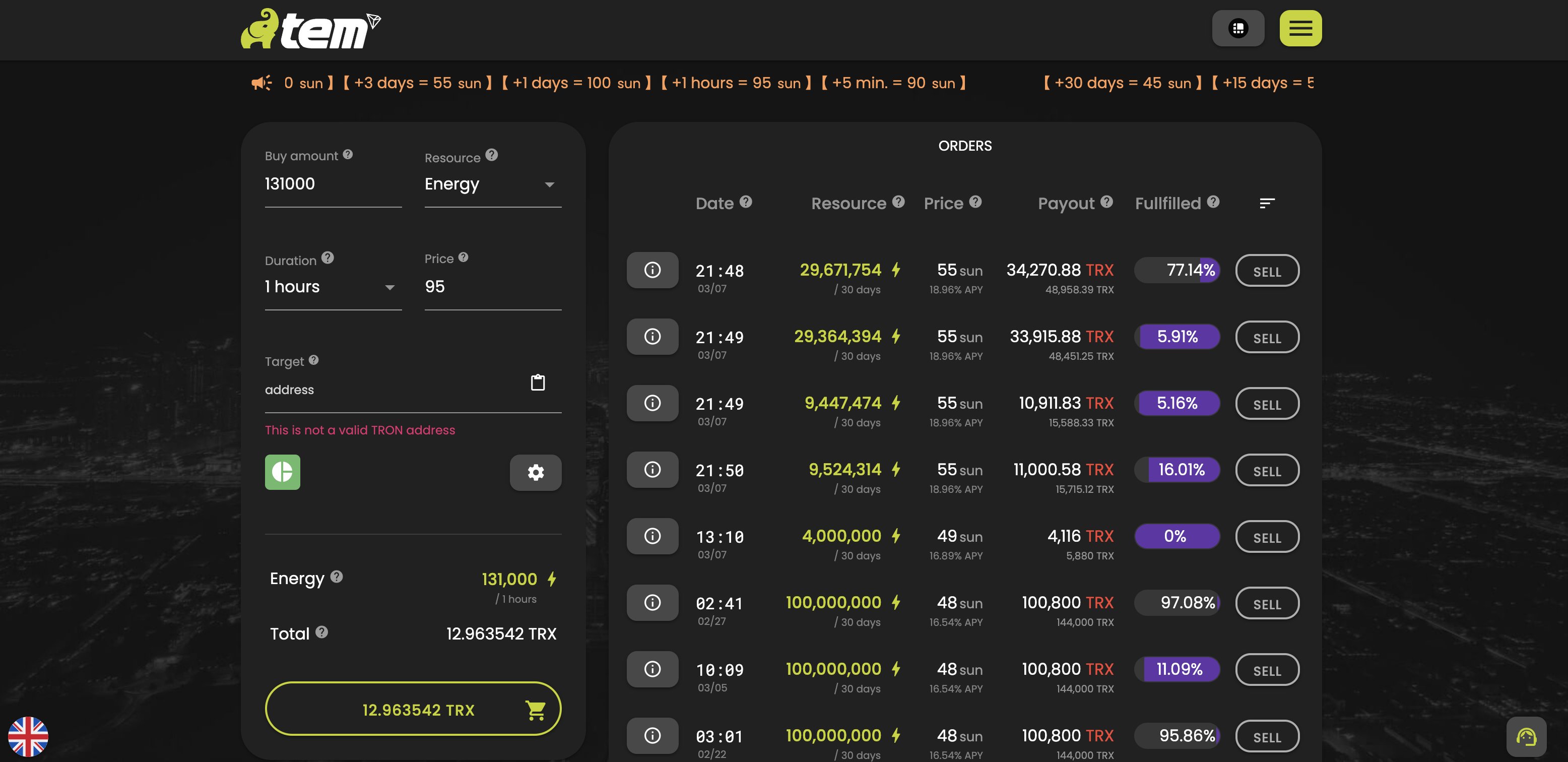
Website: https://tronenergy.market
TEM’s goal is to simplify the automatic buying, selling, and renting of Energy:
- Pool System: Orders to buy or sell Energy are processed instantly, without long waits.
- Direct TRX Rewards for Sellers: Payments are made directly in TRX, with no secondary tokens or delayed payouts.
- Buyers are guaranteed that prices will not dynamically increase based on volume.
Thanks to its pool system, you quickly receive the required amount of Energy, while sellers enjoy a stable income from renting out their resources.
6. Tron Pulse
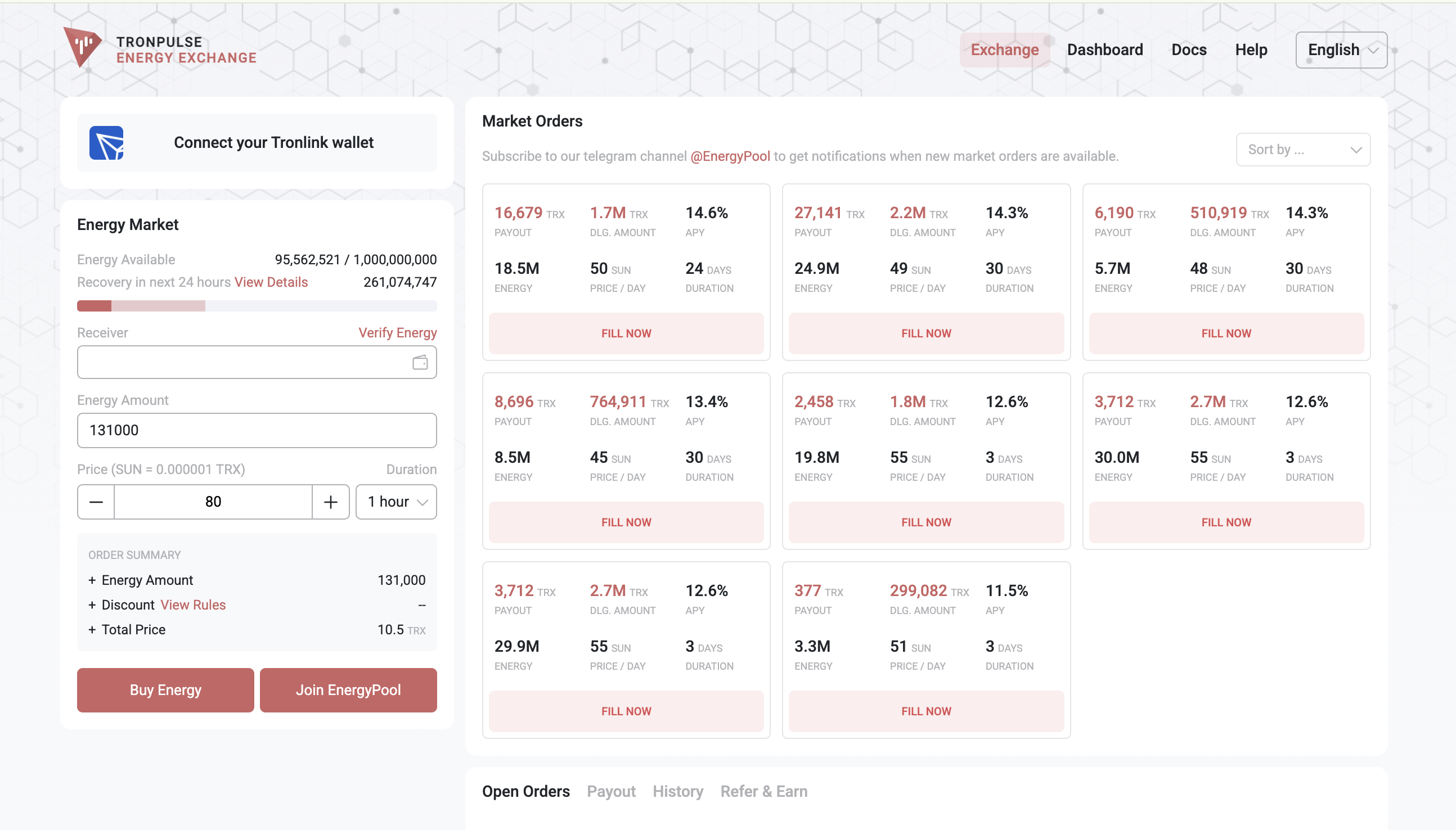
Website: https://tronpulse.io
A P2P platform where users can directly buy and sell Energy:
- Peer-to-Peer Model: Users post their own orders, and the platform connects buyers and sellers.
- User-Friendly Interface: A dashboard with analytics and detailed information about transactions.
- Integration with TronLink: No custodial risks—you control your resources directly from your wallet.
Tron Pulse is geared toward users who prefer direct resource trading with other individuals.
7. Tron Energize
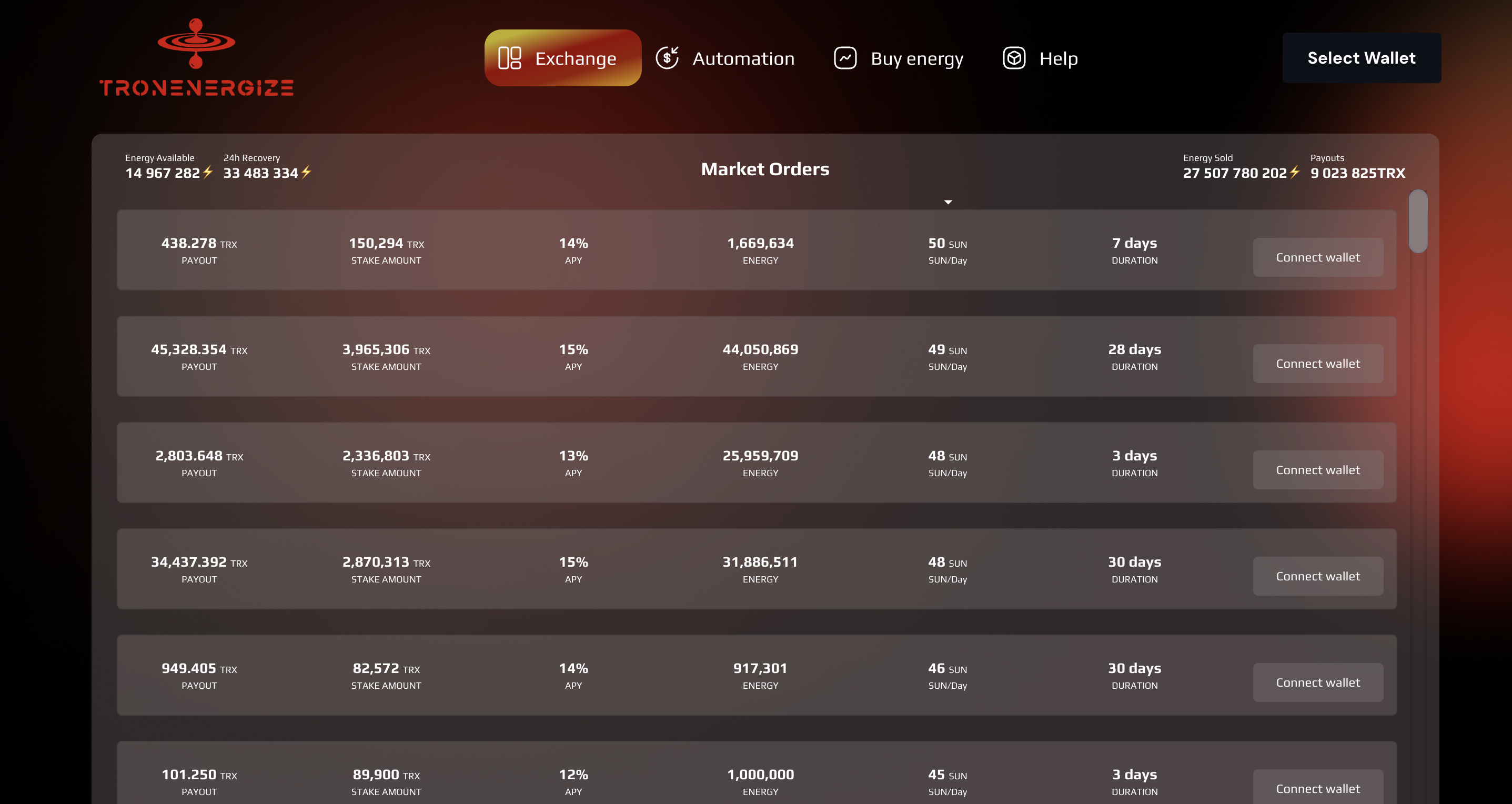
Website: https://tronenergize.com
A project focused on innovation in Energy rental:
- A P2P trading platform providing direct access to and exchange of Energy resources.
- Automation: Energy distribution through smart contracts and a decentralized infrastructure.
- Transparency: All actions are recorded on the blockchain.
Initially created to simplify and reduce the cost of renting Energy for active users in the Tron ecosystem.
8. Tron Energy
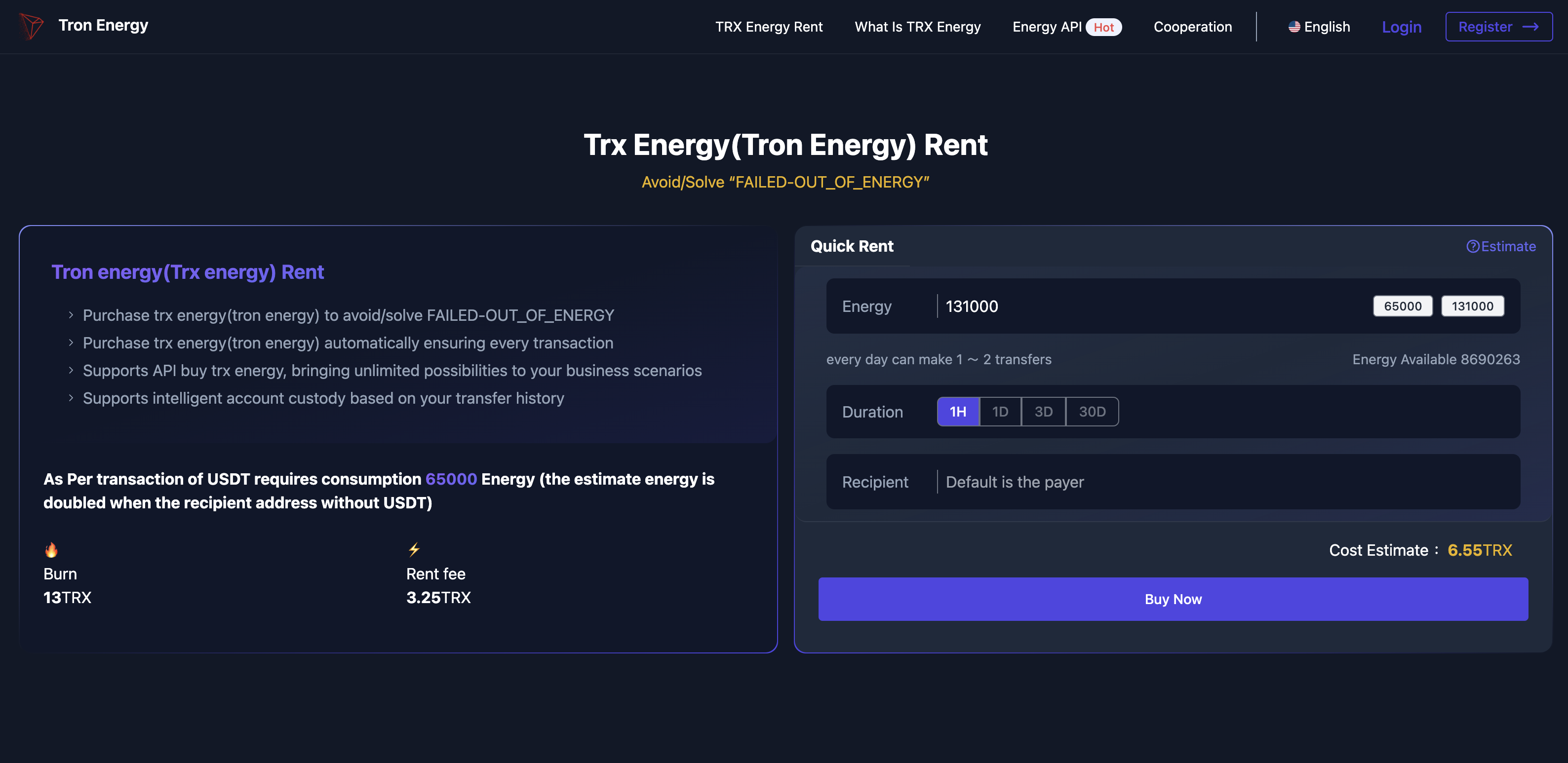
Website: https://itrx.io
A service that allows users to choose a convenient Energy rental format:
- Flexible Minimum Rental: Starting from 32,000 Energy, which is enough for transferring USDT to a wallet that already holds USDT.
- Hourly or Daily Rentals: Beneficial if you need Energy for a short period.
- Various ordering methods: manual, bulk, via API, or smart managed ordering (based on transaction history).
It is characterized by a low entry threshold and the absence of contract fees for each small transaction.
9. Tron Fee Energy Rental
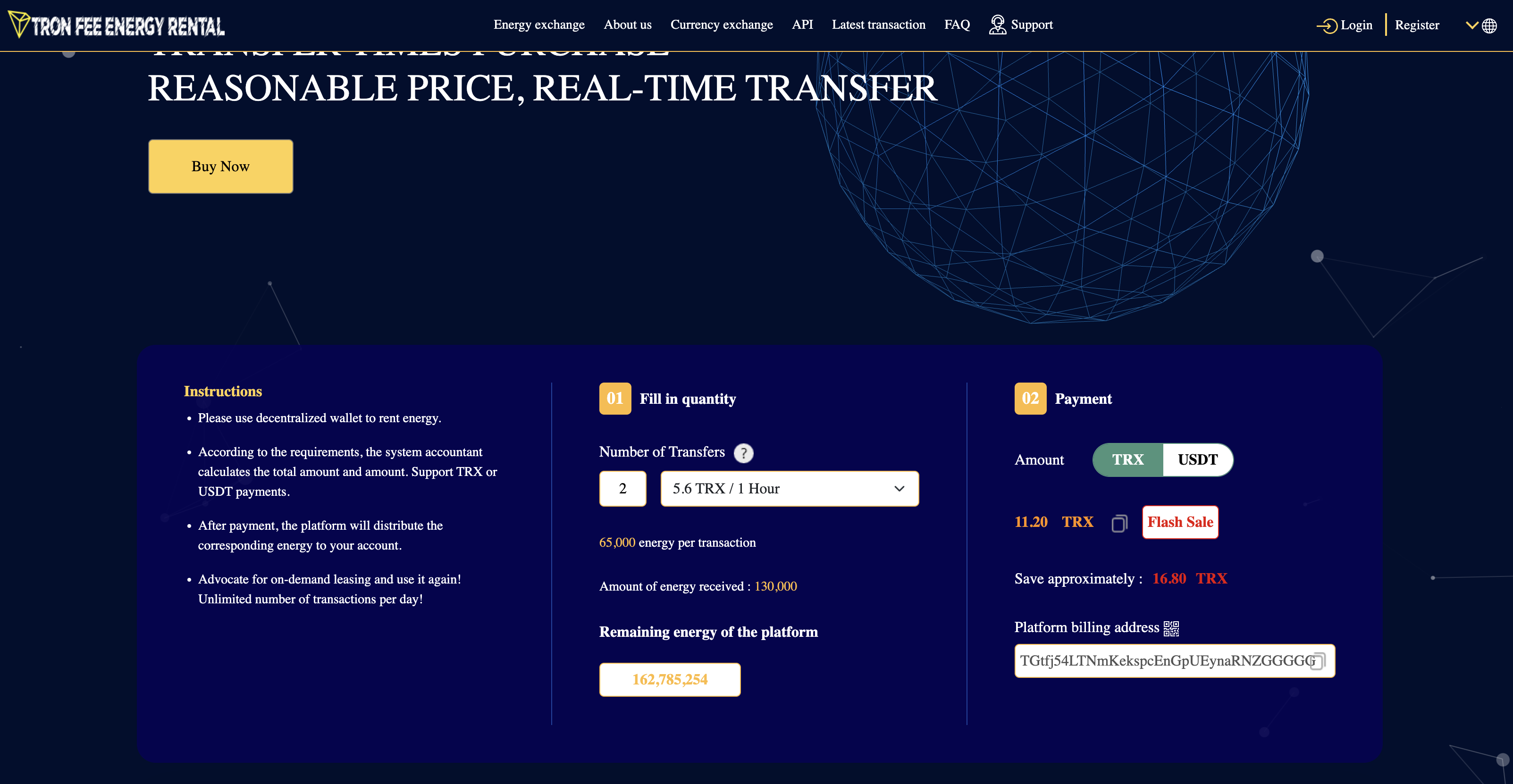
Website: https://tofee.net
A TRON Energy rental service with the following features:
- Cost Savings on Rental Fees: Up to 60% savings.
- High Transfer Speed: Transactions are processed in seconds.
- Additional Earning Potential: Users can rent out their Energy and earn commissions.
Supports payments in TRX or USDT, as well as both manual and automated (via API) leasing modes.
10. Mefree.net
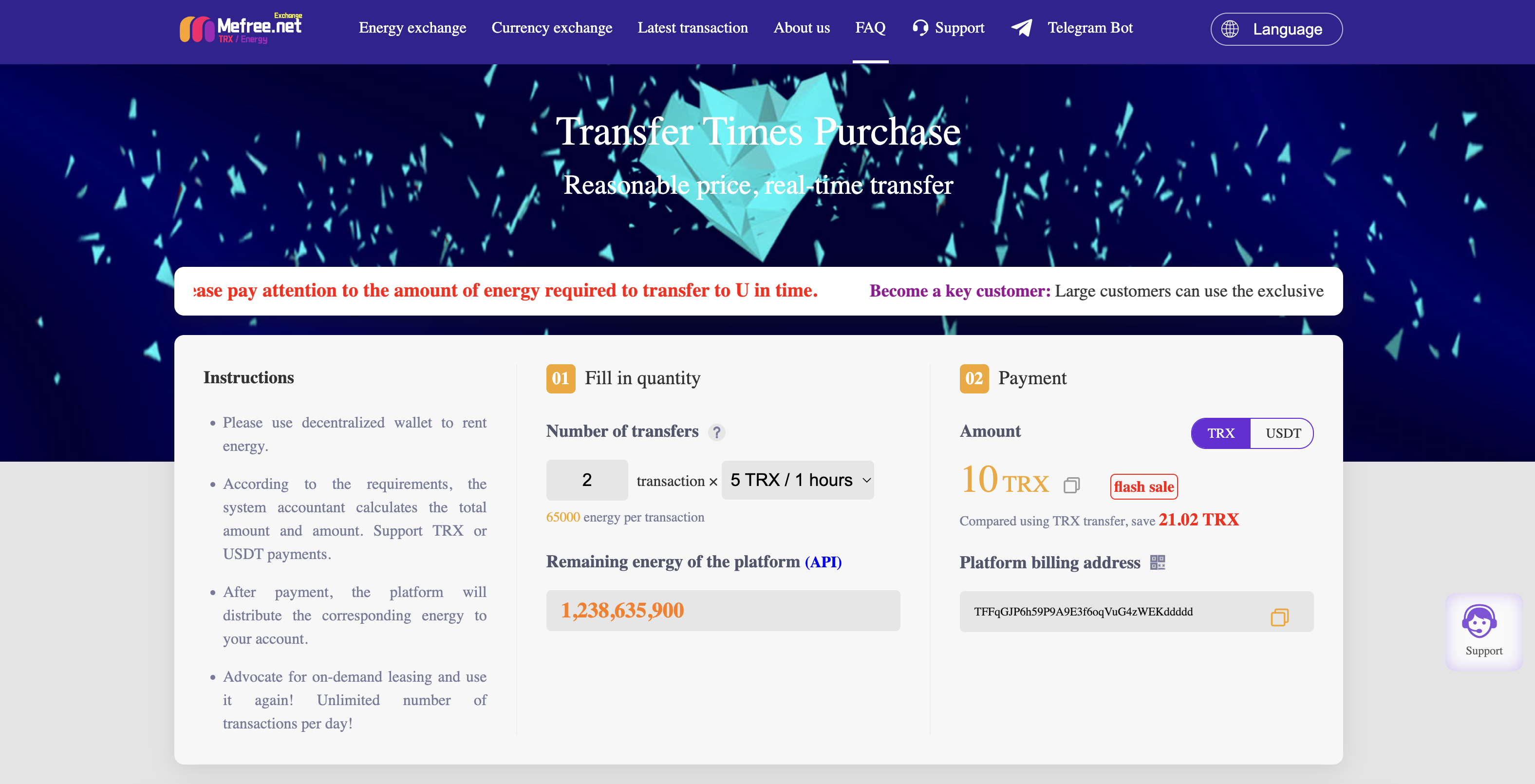
Website: https://mefree.net
The developers position this platform as a "leading provider" of Tron Energy:
- Oriented toward individual users, DApp developers, and enterprises.
- API integration for automatically renting Energy within your own applications.
- Secure transactions ensured by encryption.
Mefree.net aims to make its services accessible and efficient for different categories of clients.
11. Tron Lending
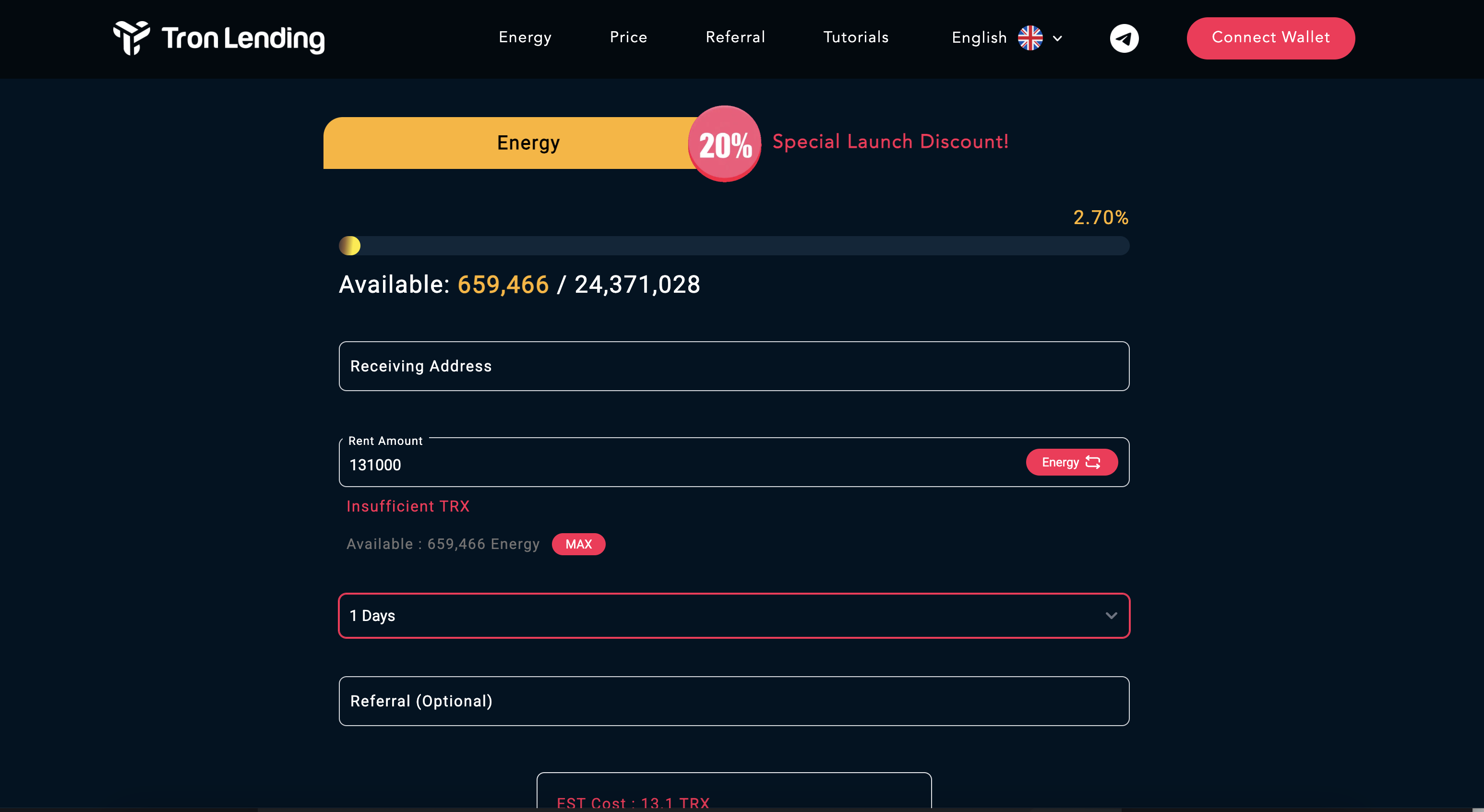
Website: https://tronlending.xyz
A self-service platform for Energy lending and resource trading:
- Reduces expenses on Energy consumption—its goal is a “revolution” in the Tron ecosystem.
- A community of developers actively supports DApp projects that lack sufficient Energy.
- Self-service tools: A comprehensive suite for managing Energy loans, collateral, returns, and more.
Additional Solutions
- DApp Egon: Simplifies access to Tron Stake 2.0, including Energy rental and transaction fee savings.
- Brutus Energy Bot: A Telegram bot that automates the rental and transfer of Tron resources.
- apitrx.com (API): A dedicated "Tron Energy market" where no user interface is required—simply send TRX to the specified address via the bot and receive Energy within seconds.
Conclusion
Renting Tron Energy is a convenient way to reduce fees when transferring USDT and using smart contracts on the Tron network without burning your own TRX or freezing large sums. Thanks to a multitude of services, users can choose the option that best fits their needs based on cost, rental duration, interface, and additional features:
- Save up to 80% by not paying TRX for every operation.
- Avoid freezing large amounts, thus keeping your liquidity.
- Rent Energy for as short as an hour or as long as a month and perform the required number of transactions without TRX fees.
- Energy recovers in 24 hours and is only consumed when a smart contract is executed.
Choose the service that best meets your requirements (level of automation, rental period, payment mechanism) and enjoy using the Tron network with minimal costs. We hope this overview helps you make the right choice and significantly save on transaction expenses.